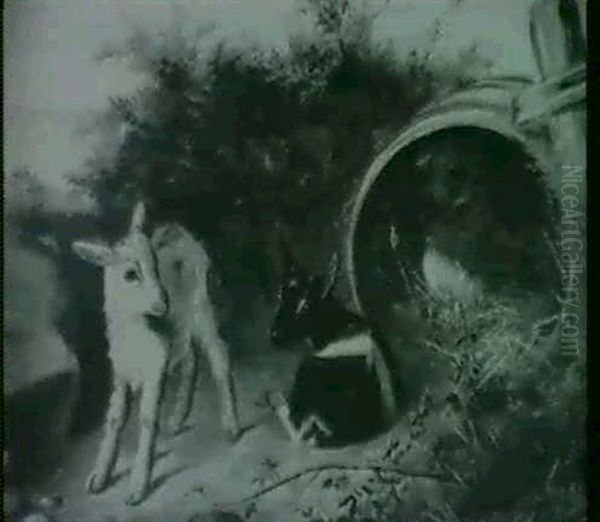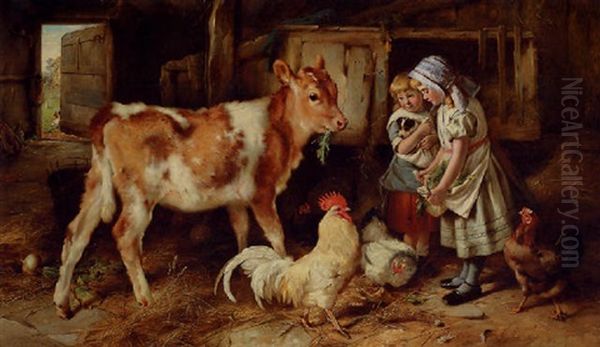Walter Hunt, born in 1861 and passing away in 1941, stands as a significant figure in the realm of British Victorian art. He carved a distinct niche for himself as a painter celebrated for his charming and meticulously rendered depictions of farmyard animals and rural life. Working primarily in oil, Hunt captured the essence of the English countryside and its non-human inhabitants with a warmth, detail, and technical proficiency that resonated deeply with the sensibilities of his time and continues to find appreciation today. His work offers a window into a specific aspect of Victorian culture – its love for animals and the pastoral idyll, presented through a lens of gentle realism.
Coming from an artistic background, Walter Hunt was immersed in the world of painting from a young age. His father, Charles Hunt (fl. 1846-1874), was also a painter, known for his genre scenes, often imbued with narrative and gentle humour. This familial connection undoubtedly provided Walter with early exposure to artistic techniques and the professional life of an artist. While details of his formal training remain somewhat scarce compared to luminaries who attended the Royal Academy Schools, his polished technique suggests a solid grounding in academic principles, whether through formal instruction, apprenticeship, or dedicated self-teaching guided by his father's example.
The late Victorian era, during which Hunt matured as an artist, was a fertile ground for animal painting. Artists like Sir Edwin Landseer had elevated the genre, imbuing animal subjects with human-like emotions and narratives that captured the public imagination. While Hunt operated within this tradition, his approach often favoured a more direct, less overtly anthropomorphic portrayal of animals in their natural environments, focusing on accurate observation and the inherent charm of his subjects.
The Heart of the Farmyard: Subjects and Themes

Walter Hunt's artistic world revolved around the farmyard. His canvases are populated with the familiar creatures of rural England: calves, horses, donkeys, goats, and dogs, particularly terriers. He seemed especially drawn to depicting young animals, capturing the innocence and vulnerability of calves nestled in straw or the playful interactions between puppies. These scenes often take place within the rustic interiors of barns and stables, allowing Hunt to explore the interplay of light and shadow across wooden beams, hay-strewn floors, and the textured coats of the animals themselves.
His choice of subject matter tapped into a Victorian fondness for domesticity, rural life, and the perceived innocence of animals. Unlike painters who focused on the grandeur of wild beasts, such as Briton Rivière, or the dynamic energy of the hunt, like Heywood Hardy or John Emms in his depictions of hounds, Hunt concentrated on the quieter, everyday moments of farm life. His paintings often possess a gentle narrative quality – a dog protectively watching over sleeping calves, a donkey patiently waiting in its stall, or mismatched animal companions sharing a space.
Horses were another favourite subject, often depicted not as racing thoroughbreds in the vein of John Frederick Herring Sr. or Jr., but as sturdy working animals or gentle companions within the stable environment. Hunt excelled at rendering their powerful forms, glossy coats, and expressive eyes. Similarly, his donkeys are portrayed with empathy, highlighting their patient and often stoic nature, a contrast to the more aristocratic subjects favoured by some contemporaries.
A Style Defined by Realism and Detail
Walter Hunt's style is firmly rooted in realism. He possessed a keen eye for observation and a remarkable ability to translate the textures and forms of the natural world onto canvas. His rendering of animal fur, whether the soft down of a calf, the rough coat of a donkey, or the wiry hair of a terrier, is exceptionally skillful. He paid meticulous attention to anatomical accuracy, ensuring his animals were believable and lifelike, standing in contrast to the sometimes overly sentimentalised or stylised depictions found elsewhere.
His use of colour was rich and vibrant, yet typically maintained a naturalistic feel. He masterfully handled light, often employing the soft, directional light filtering into a barn or stable to model forms and create atmosphere. This careful manipulation of light and shadow adds depth and a sense of three-dimensionality to his compositions. Unlike the broader, more atmospheric landscapes of someone like Thomas Sidney Cooper, known for his cattle and sheep in pastoral settings, Hunt's focus remained tightly on the animals and their immediate surroundings, rendered with crisp detail.

Hunt's brushwork, while precise, was not overly laboured. It retained a certain fluidity that contributed to the lifelike quality of his subjects. He built up surfaces with careful layers, achieving both fine detail and a sense of substance. This technical facility allowed him to capture not just the appearance of the animals, but also a sense of their individual character and disposition, avoiding the generic quality that could sometimes affect lesser animal painters of the period. His dedication to detail might echo the principles valued by the Pre-Raphaelites, though his subject matter and overall aesthetic remained distinct from their movement.
Notable Works and Compositions
Several paintings exemplify Walter Hunt's skill and typical themes. "The Dog in the Manger" is a recurring subject in art, and Hunt tackled it with his characteristic charm and observational acuity. His versions typically depict a terrier assertively occupying a manger filled with hay, preventing the rightful occupants, often calves or foals, from feeding. These works showcase his ability to capture animal interaction and expression, conveying the dog's possessiveness and the calves' tentative curiosity or frustration.
"Best of Friends" is another title indicative of the sentimental narratives popular in the Victorian era. Such works often depicted amicable relationships between different species – a horse and a dog, or calves and puppies sharing a stall. Hunt rendered these scenes with a warmth that appealed directly to Victorian sensibilities about loyalty and companionship in the animal kingdom, akin to themes explored by artists like Horatio Henry Couldery, known for his charming depictions of kittens and cats.
"An Ill-Matched Pair" likely featured animals of contrasting size or temperament sharing a space, allowing Hunt to explore visual humour or gentle narrative through juxtaposition. This title suggests a focus on the individual personalities of the animals and their reactions to each other, a hallmark of his intimate approach to farmyard life. Similarly, "Asleep in the Manger" uses a common setting but focuses on the peacefulness of slumbering animals, perhaps young calves, rendered with soft light and meticulous detail in the straw bedding.
Other works, such as "Feeding Companions," "The Orphan," or simply studies of calves, horses, or donkeys in stables, consistently demonstrate his strengths: strong composition, often using the architecture of the barn to frame the subjects; realistic portrayal of animal anatomy and behaviour; and a mastery of texture and light. These paintings were not grand historical statements, but intimate, beautifully crafted observations of rural life.
Context within Victorian Animal Painting

Walter Hunt's career unfolded during a peak period for animal painting in Britain. Sir Edwin Landseer (1802-1873) had dominated the previous generation, achieving immense fame with works like "The Monarch of the Glen" and "Dignity and Impudence." Landseer often imbued his animal subjects with complex human emotions and moral narratives. While Hunt certainly benefited from the public appetite for animal art that Landseer fostered, his own work generally maintained a more straightforward, observational stance, focusing on the inherent qualities of the animals rather than overt anthropomorphism.
Compared to Briton Rivière (1840-1920), whose works often featured dramatic encounters or classical themes involving animals (e.g., "Daniel's Answer to the King"), Hunt's paintings are quieter and more domestic. He shared a focus on realism with contemporaries like John Sargent Noble (1848-1896), known for his depictions of bloodhounds and deerhounds, often in Highland settings, but Hunt's primary domain remained the farmyard.
His detailed rendering of cattle invites comparison with Thomas Sidney Cooper (1803-1902), the pre-eminent painter of cows and sheep, often set within idyllic Kentish landscapes. However, Cooper's focus was typically broader, incorporating more landscape elements, whereas Hunt usually zoomed in on the animals within their stable or barn environments. Hunt's work perhaps shares more in common with artists like John Frederick Herring Jr. (1820-1907), who, like his father, painted horses extensively, but also depicted farmyard scenes with a similar attention to detail and popular appeal.
Other contemporaries included specialists like John Emms (1844-1912), renowned for his vigorous paintings of foxhounds and terriers, often capturing their energy and character with looser brushwork than Hunt's. Maud Earl (1864-1943) and Arthur Wardle (1860-1949) were also highly successful animal painters, known for their depictions of dogs and, in Wardle's case, a wider range of animals including big cats. Hunt's specific focus on the gentle life within the farmyard, particularly his sensitive portrayal of calves and donkeys alongside dogs and horses, helped distinguish his contribution. He found a balance between anatomical accuracy, appealing subject matter, and technical polish that proved highly successful. Even earlier painters like George Morland (1763-1804), known for his rustic scenes often featuring pigs and donkeys, provided a historical precedent for the type of humble rural subjects Hunt favoured, though Hunt's style was tighter and more detailed, reflecting later Victorian tastes. William Huggins of Liverpool (1820-1884), known for his intense studies of lions and tigers but also farm animals, represented another strand of Victorian animal painting focused on powerful individual portraits.
Exhibitions, Recognition, and Legacy
Walter Hunt achieved considerable success during his lifetime, exhibiting regularly at prestigious venues. He showed numerous works at the Royal Academy in London between 1881 and 1911, a key indicator of professional recognition in the British art world. His paintings were also exhibited at other major institutions, likely including galleries in Liverpool, Manchester, and Birmingham, which were important centres for the arts.
The popularity of his work is evidenced by the frequency with which his paintings appear on the art market today. His detailed, accessible, and often charming subjects held broad appeal for the Victorian and Edwardian public. Many homes would have aspired to own such depictions of peaceful rural life and beloved animals. It is likely that reproductions of his work were also circulated, further broadening his reach. His paintings entered public collections, ensuring their preservation and continued visibility, with examples held in various UK provincial galleries.
Hunt continued painting into the early 20th century, maintaining his characteristic style and subject matter. He died in 1941, amidst the turmoil of the Second World War. By this time, artistic tastes had shifted dramatically, with modernism challenging the foundations of traditional representational art. However, the appeal of Hunt's work endured, particularly among collectors of Victorian art and those with an appreciation for animal painting.
His legacy lies in his contribution to the rich tapestry of British animal art. He was not a radical innovator who changed the course of art history, but rather a master craftsman who perfected a particular genre. He captured the specific atmosphere of the Victorian farmyard with unparalleled detail and sensitivity. His paintings serve as more than just depictions of animals; they are beautifully rendered documents of a way of life and a reflection of the values and sentiments of his era. For those who appreciate meticulous technique, gentle narratives, and the enduring charm of the animal world, the work of Walter Hunt remains a source of considerable pleasure and interest. He stands as a testament to the depth and diversity of talent within the Victorian art scene, a specialist who brought the humble inhabitants of the farmyard to life with skill, empathy, and enduring appeal.